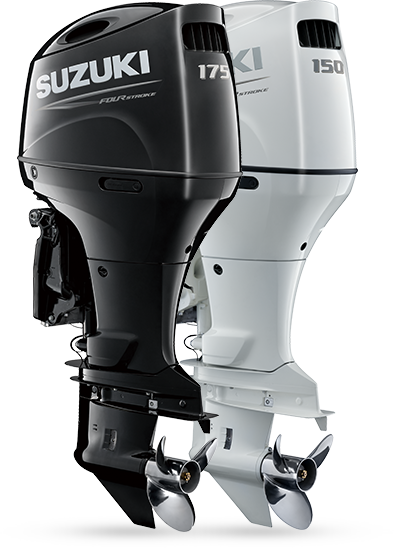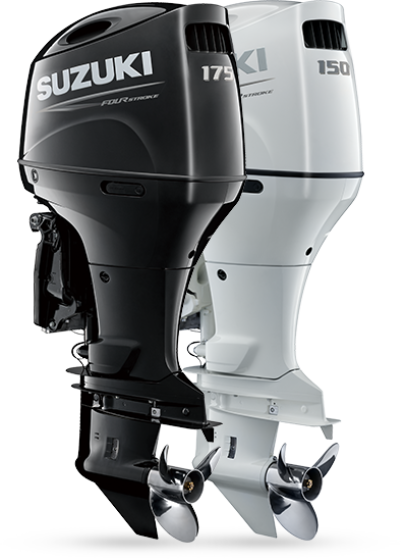DF175AP / DF150AP
CHARACTERISTICS
Suzuki Selective Rotation Technology
Suzuki's Selective Rotation Technology, the world's first technology that allows changing the direction of propeller rotation, is adopted for the first time in its class. By installing two or more outboard motors on a boat, they can be converted to counter-rotation by changing the direction mode and installing counter-rotation propellers * 1.
Consult your dealer before changing standard rotation to reverse (or vice versa).
The optional link and additional propeller are needed to change the spin of the outboards.
Suzuki Precision Control
Precise throttle controls with smoother, more immediate response are achieved by adopting the Suzuki Precision Control system, a technologically advanced, computer-based control system that replaces the mechanical control cables found in conventional control systems with electronic wiring that eliminates the source of friction and resistance. When combined with Suzuki's Exhaust Control System, improved fuel economy is achieved across a wide range of operations from low speed to high revs.
- Suzuki's "Big Block" four-cylinder engine uses a large displacement of 2,867cm3 and a high compression ratio to produce 129.0kW (175PS) and 110.0kW (150PS), for impressive acceleration and more torque at low revs.
- Knock sensors, O2 and water detection system, provide greater operational reliability.
- The Variable Valve Timing (VVT) system increases low- to mid-range torque for greater acceleration.
- The Multi-Stage Induction System improves high-rpm performance.
- The air filter further reduces operating noise for a quieter engine.
- The Keyless Start system offers easy, stress-free starting. It also works as a security system to prevent theft.
- The matte-pearl black color and 3D symbols create a sophisticated look.
TECHNOLOGY
- STRONG
- EFFICIENT
- RELIABLE
- INNOVATORS
Advanced technology for performance
Big Block—High Performance Engine
The DF175AP / 150AP are equipped with 4 cylinders, with a total displacement of 2,867cm3. The block is completed with a DOHC power head that provides four valves per cylinder for high performance. While the large displacement allows for both excellent acceleration and speed, our engineers ensure that the final dimensions of the outboard are as compact and light as possible.
Both outboards feature some of Suzuki's best advanced technologies developed to extend engine performance.
High compression ratio of 10.2:1 and the largest displacement in their class*2
Compression and capacitance play an important role in performance and power. Displacement has a direct effect on acceleration and torque, so a larger capacity will generally yield more. Higher compression ratios allow the engine to get more out of the combustion process resulting in noticeable improvements in performance and power. Drawing on our experience in building motorsport racing engines, Suzuki engineers combined the 2,867cm3 displacement with a 10.2:1 compression ratio resulting in more power and better performance.
*2: as of August, 2016.
Selective Rotation System
Large boats equipped with multiple outboards generally pair a standard outboard rotation with a counter-rotation model to keep the boat on a straight line. Once the purchase of a special counter-rotation model is required, Suzuki's innovative Selective Rotation technology eliminates that need by incorporating a special unified design of gears, shaft and bearings in the leg, which allow the outboard to operate reliably and efficiently in any direction. Available in both DF175AP and DF150AP modes, reverse rotation requires an optional enable switch connected to a circuit inside the engine compartment, as well as the installation of a reverse rotation propeller
*1: Consult your dealer before changing standard rotation to reverse (or vice versa).
The optional link and additional propeller are needed to change the spin of the outboards.
Semi-direct air intake system
The DF175AP / DF150AP have a modern design, which gives an innovative look. But the design is not only for appearance. Integrated under the hood is a semi-direct air intake system that delivers cooler air directly to the engine resulting in greater acceleration and speed.
Advanced technology for performance and smooth operation
Precision Control System
Suzuki Precision Control is a technologically advanced electronic control system that replaces the wire control cables found in conventional control systems with electronic wiring that eliminates friction. While you enjoy smooth throttle and shift operation with minimal friction, the system's computer processes and transmits real-time commands to the engine actuators providing precise throttle control with smoother, more immediate response. This is most evident in the low-rpm range, where operation is noticeably smooth and precise. When combined with the Suzuki Exhaust Control System, it allows control of fuel and air flow to increase the limit of the controlled rev range, improving fuel economy in a wide range of operations. Suzuki Precision Control also has built-in systems that protect the engine and combat damage due to poor handling, and the design and simple wiring make installation easy, reducing the time required for fitting and adjusting.
The system offers precision control for single, double, triple or quad installations as well as dual stations.
Lean Burn Control System
Suzuki's Lena Burn Control System is an intelligent fuel delivery system that achieves significant improvements in fuel consumption making already fuel efficient four-stroke engines even more economical. By monitoring engine performance and operating conditions in real time, the system uses the onboard 32-bit ECM to predict fuel needs and deliver a more accurate fuel mixture throughout the outboard's operating range. The results show significant improvements in fuel economy across the powerband, including the cruising range where the engine is used most of the time.
Weight Compensation System
One of the inherent characteristics common to in-line four-cylinder engines when operating at high rpm is an aftershock that lines up directly with the piston movements. To counteract this vibration, Suzuki engineers use a secondary balancing system that compensates for piston movement with horizontal motion. To achieve this, the balancer is split into a left and right section, each of which rotates in the opposite direction at twice the speed of the crankshaft, effectively compensating secondary vibrations and achieving smoother engine operation.
Oxygen Control System
A very important sensor for the electronic fuel injection system, the O2 feedback control system provides accurate real-time information that the ECU uses to manage the fuel/air ratio as operating conditions change. Used on many of Suzuki's top-of-the-line outboards, the O2 control system helps maintain optimal engine operating efficiency throughout the full engine operating range.
Silencer
The engine exhaust system is a well-known source of engine noise, but another, often overlooked source is the intake manifold. Air drawn into the intake manifold at high speeds can create a harsh sound. The DF175AP / DF150AP has a built-in air intake detector, which reduces this noise operation, making them extremely quiet.
Impact sensor
The knock sensor monitors combustion to provide the ECM with the information needed to precisely manage engine timing for optimal performance. In addition to maximizing power output, the system also helps increase engine durability.
Special Engine Mounts
Both the DF175AP and DF150AP incorporate a combination of soft and high thrust rubber mounts on both upper and lower mounts to reduce engine vibration and ensure stable operation. Soft-type rubber mounts are used to absorb the vibrations produced at idle through 2,000 rpm. while high strength rubber mounts provide stable operation under high loads increasing power and efficiency.
Variable Valve Timing (VVT)
Variable valve timing is used in many of Suzuki's leading outboards to deliver high performance while retaining the benefits of four-stroke technology. VVT is used to change the intake valve timing through the camshaft timing. Combined with the rest of the engine's features, VVT provides low- to mid-range torque for stronger acceleration. The whole process is done automatically leaving you to enjoy the power and performance.
Silent mode
Suzuki's four-stroke outboards have been recognized for their extremely quiet operation. Suzuki engineers go to great lengths to incorporate methods designed to keep the engine running as quietly as possible
Variable Length Insertion System (MSI)
Getting the right amount of air in the cylinder has a big effect on performance. High speed operation usually requires more air, and correspondingly lower speeds, less. Suzuki's multi-stage intake system meets these needs by using two intake manifold pipes per cylinder to ensure the engine receives the correct amount of air. As the revs increase, the valves open in the direct intake pipes. This results in faster and more resistanceless introduction of more air into the cylinder and by extension better engine performance in high speed operation.
Shifted Central Axis
Pioneered by Suzuki, the use of a drive shaft in four-stroke outboards has long been used to reduce their size. This technology is found on all DF70A series engines and above, shifting their center of gravity forward. While the design contributes significantly to overall engine ergonomics and increased power output, it also moves the engine's inertial axis, resulting in reduced vibration. Providing a final gear ratio of 2.50:1 - the largest you can find in their class - it offers strong torque for quick acceleration and higher speeds.
The data used in the charts was obtained through internal testing under specific conditions. Results will vary depending on operating conditions (boat design, size, weight, weather, etc.)
Sophisticated Electronics And Design With Convenience In Mind
32-Bit Engine Control Module (ECM).
Both the DF175AP and DF150AP use a 32-bit ECM (Electronic Engine Control Module) that provides precise control over engine operation, particularly the ignition and fuel delivery systems. This powerful on-board computer monitors and processes key data collected in real-time from an array of sensors placed in areas vital to the engine's operation. These sensors include the Manifold Absolute Pressure Sensor, Intake Air Temperature Sensor, Shift Position Sensor, Throttle Position Sensor, Cylinder Wall Temperature Sensor, Camshaft Position Sensor, and Exhaust Manifold Temperature Sensor. Using this data, the computer provides precision control of the engine's ignition and fuel systems by maintaining optimal spark and fuel delivery under all operating conditions.
High Performance Alternators
Today's boats are equipped with a wide range of electronics that require plenty of power flow to keep them running. With this in mind, Suzuki engineers have fitted the DF175AP and DF150AP with an alternator that produces the majority of the maximum 44A (12V) power with the engine running at a low power of 1,000rpm. for most occasions.
Multipoint Electronic Fuel Entry
Suzuki pioneered the use of electronic fuel injection in four-stroke outboard engines with the launch of the original DF70 / 60 in 1997. This system feeds each of the engine's cylinders with an optimized mixture of fuel and air that is injected into the cylinder at high pressure according to commands from the brain's 32-bit computer. The system offers improved fuel economy, better acceleration and reduced emissions that meet the specifications. It also complies with the standards of the Recreational Craft Directive (RCD), Directive 2003 / 44EC of the European Parliament and of the Council and received a 3-star rating from the California Gas Resources Board (CARB);
Keyless start system*3
The new keyless start system from Suzuki uses a special key fob that transmits a password to the engine start system. As long as you have the key fob, all you need to do is stand one meter away from the console, connect the emergency switch cable, turn on the main switch and start the outboard with the push of a button. With the key remaining secure in your pocket, the system offers simple, effortless operation while reducing the risk of key loss.
*3:Availability may vary in some regions. For more information, contact your local Suzuki dealer.
Water-cooled voltage regulator with isolators
The water-cooled voltage regulators incorporated in both models dissipate heat in the regulator to improve durability. The battery charging system also incorporates an isolation function that allows the use of two batteries. The system splits the electrical current into two circuits and designed to protect the primary battery in case the secondary battery runs out.
Fuse box
The fuses for the engine's electrical system are housed in a fuse box located on the side of the engine. This design keeps the exterior of the engine simple while still providing easy access.
Slope Limit System
To protect the boat and engine from damage that can occur when the engine tilts, both outboards have a built-in user-adjustable tilt limit switch that prevents the engine from tilting beyond a preset point.
Double Engine Cleaning Ports
Over time, salt, sand and dirt build-up can restrict flow in the cooling system causing damage. To prevent this buildup, both outboards are equipped with two purge ports that make flushing the cooling system as easy as possible. With these two ports you will always have easy access to the flushing system, whether the boat is in or out of the water.
Water Detection System
Water in the fuel can lead to problems including poor combustion, lower power output and corrosion. The Suzuki Water Detection System is designed to protect the engine from fuel moisture by using a water-sensing fuel filter to alert the operator with visual and audible warnings when water is present in the fuel. The filter is designed to allow you to visually check the water.
Suzuki anti-corrosion treatment
All Suzuki outboards are specially formulated with an anti-corrosion treatment. By applying the anti-corrosion agent to the metal, the materials, anti-corrosion agent and aluminum are allowed to bond, creating a panacea against corrosion.
STANDARDS
MODEL DF175AP*6
RECOMMENDED TRANSMISSION HEIGHT mm L:508, X:635
STARTING SYSTEM Electric
WEIGHT kg *4 L:236, X:241
ENGINE TYPE DOHC 16-Valve
FUEL SUPPLY SYSTEM Multi-Point Sequential Electronic Fuel Injection
CYLINDERS 4
CUBIC cm3 2.867
DIAMETER × HEIGHT mm 97 × 97
MAXIMUM POWER kW 129.0
FULL POWER OPERATING RANGE rpm 5,500-6,100
STEERING SYSTEM Remote
OIL TANK CAPACITY Lit. 8.0
IGNITION SYSTEM Fully-transistorized
ALTERNATOR 12V 44A
ENGINE BASE Shear Mount
CONTROLS Power Trim and Tilt
GEAR RATIO 2.50:1
SPEEDS F-N-R (Drive-by-Wire)
EXHAUST Through Prop Hub Exhaust
PROPELLER OPTIONS (Step)*5
All propellers are 3-blade type. 15"-27.5"
*4:Dry weight: Battery cable is calculated, propeller and engine oil are not calculated.
*5: Please contact your local dealer for propeller details.
*6: Rotation selection model.
The appearance, colors and equipment of outboards may vary depending on your supplier.
Specifications are subject to change without prior notice.
*Manufacturer information






